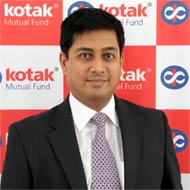Harsha Upadhyaya, CIO – Equities, Kotak Mahindra Asset Management talks to Cafemutual about what he expects from the markets in 2015, about the funds managed by him and more.
 Can you take us through the
investment philosophy of Kotak AMC?
Can you take us through the
investment philosophy of Kotak AMC?
Our investment style is predominantly ‘growth at reasonable price’ (GARP). We follow a blend of top-down and bottom-up approach for portfolio construction in order to derive value from macro trends and security specific opportunities.
From a top-down perspective, we adopt a thematic approach, whereby we identify themes that can outperform or underperform the market over a rolling 12-month period. Once the themes are identified we drill them down to sectors or sub-sectors that will benefit or fail to benefit from these themes. Our expectation of the direction of macro variables as well as the way market is positioned, play an important role in identifying the right themes. Sector exposures also rely on change in future return on capital employed (ROCE), return on equity (ROE), free-cash, earnings momentum and are passed through relative or absolute valuation filters.
Our bottom-up approach adopts the Business, Management, Valuation (BMV) approach to stock picking. We try to look for businesses that are scalable in nature, where capital efficiency is high and that have reasonable competitive edge in their respective areas of business. We also very keenly look at the management track record and its quality. The final filter is valuation in every case. All equity funds under our management follow this broad approach, while sticking true to the spirit of their respective investment mandates.
Do you think the markets have the potential to deliver the kind of performance which we saw in 2014?
The returns from equities are likely to be more moderate in 2015 as compared to 2014. However, we believe, there is still reasonable upside in equities given expected rebound in earnings growth.
In the beginning of 2014, Indian equities were trading at a discount to long term average valuations. The valuation gap was significantly higher in mid-small caps compared to large caps. The strong performance of mid-small caps last year was led by rerating in valuations from discount to par on long term average and rebound in earnings growth. This resulted in mid-small caps outperforming large caps by a huge margin. 2015 is unlikely to present such a differential performance between segments as the valuations in both segments are broadly same and near long term averages. In fact, we believe the mid-small cap segment is likely to be more volatile this year compared to last year.
Equity markets have been on a roll and the government has increased the investment limit for tax benefits in 80 C products from Rs. 1 lakh to Rs. 1.50 lakh. Do you think this hike will result in higher inflows in ELSS?
ELSS funds are likely to provide better long term returns as compared to other available investment options under Section 80C. The lock-in of 3 years is also shorter compared to other options under Section 80C. Given all this, we believe that the increase in investment limit under Sec 80C will drive higher interest in ELSS funds.
In which sectors/theme/companies will you deploy the new inflows which Kotak Tax Saver will attract this season? In which pockets do you see opportunities at this juncture?
Last year, we initially focussed on high operating leverage sectors on the expectation of possible economic recovery in domestic market. We also bet on oil marketing companies in anticipation of softness in global crude prices and diesel deregulation. In the past few months, our positioning is driven largely by interest rate sensitive sectors, as we expect benign interest rates going forward.
Tell us about the investment strategy of Select Focus Fund. The fund has outperformed its benchmark over 1, 3 and 5 year period. What worked in its favour?
The investment philosophy of Kotak Select Focus is built on the premise that different sectors of the economy perform varyingly over different periods of economic cycle. The investment focus is to invest in select sectors that are likely to outperform broader market at various points of time. Once the sectors are selected through top-down analysis, the individual investment ideas within those sectors are picked up through bottom-up approach.
The fund maintains 4-9 sectors in its portfolio. So, while it is a concentrated strategy at the sector level, we keep it diversified at stock level (generally around 45 stocks in the portfolio). Its investment mandate also provides flexibility to move across market capitalisation. Investments in mid/ small cap stocks can go up to 50% of the portfolio.
Both sector allocation and stock selection have aided portfolio performance. Typically, we look for compounding characteristics of earnings growth at reasonable valuations, and build portfolio around that strategy. We do not invest in sectors and stocks that require capital on regular basis and those with high degree of leverage. We also tend to avoid companies that have high level of policy/ regulatory risk. We avoid betting on event based plays. Some of this investment discipline has helped in delivering consistent performance.
What cues (domestic and global) are you looking forward to at this juncture?
From the domestic perspective, in the immediate short term, all eyes are on Union Budget. In the medium term, investors are looking forward to further interest rate cuts and revival in earnings momentum. Globally, survival of Greece in Euro or otherwise, will be watched closely in the short term.




